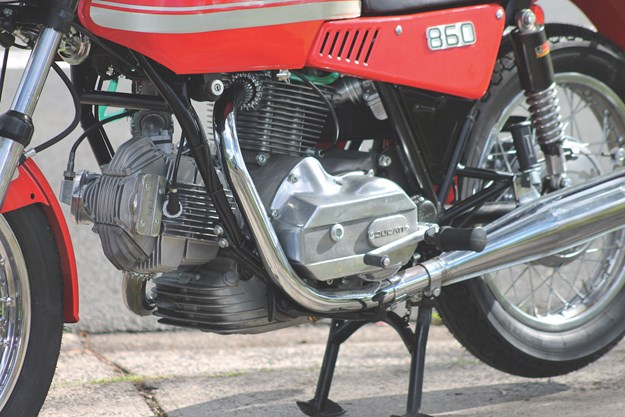Unique Bikes: 860 GT
Ducati's Giugiaro-designed roadster was a big step for the marque
|
|
|
Ducati 860 GT
|
In the early 1970s Ducati was a minor Italian manufacturer known primarily for producing smaller capacity overhead camshaft singles. But everyone wanted a Superbike and Ducati was no exception.
Without the resources to create a three- or four-cylinder Superbike, Ducati’s chief engineer Fabio Taglioni took two existing 350cc singles and placed them on a common crankcase with the cylinders 90 degrees apart. As an engineering purist, Taglioni chose the 90-degree layout for several reasons. He preferred it, because it offered perfect primary engine balance and with this layout the engine could be very smooth, with only some high-frequency secondary imbalance.
Also, theoretically, the twin could be little wider than a single so the engine could be kept low in the frame, while maintaining good ground clearance.
The first bevel-drive 750 only lasted three years before the new 860 GT replaced it.
The release of the Ducati 860 GT in 1974 was the harbinger of a change in direction for Ducati. Prior to the this model, Ducati’s design had been a result of gradual evolution, but for the 860 Ducati engaged the services of an outside stylist, Giorgetto Giugiaro. He, of course, became famous for the first-generation VW Golf, Alfa Romeo Giulia Sprint, Maserati Merak, Lotus Esprit and numerous other iconic cars.
But there was more to the 860 than a cosmetic restyle of the earlier 750 GT.
The most noticeable feature of the 860 engine was the redesigned outer engine covers. This included the alternator, clutch, bevel and gearshift covers. Underneath the reshaped alternator cover was a new bevel-gear drive to the two vertical shafts, and instead of the 750’s ignition points housing between the cylinders was an oil filter. Apart from a pair of 86mm pistons and shorter conrods, most of the other engine internals were unchanged. The stroke remained at 74.4mm but the 860 now featured electronic ignition, and with a pair of Dell’Orto PHF 32mm carburettors and angular Lafranconi mufflers.

The 860 GT’s power was modest (no claims were made but it was around 65 horsepower) and mid-range torque was improved over the 750.
The 860 GT was released in a blaze of publicity, with rave reviews from the press.
But the media claims of "The Best Duke Yet" were not translated in to sales. Although history has been unkind to the 860 GT, some of its misfortune was due to unfortunate timing. The 860 GT’s release coincided with a worldwide motorcycle sales slump and the more European inspired 860 GTS soon replaced it. But finally the 860 GT’s time has possibly come. As modern motorcycles adopt a hard-edged style, the 860 GT has begun to look more contemporary, something few 50-year-old motorcycles can emulate.
This history was provided by renowned Ducati expert Ian Falloon. The bike you see here, a very early example, is coming up for auction with Donington at the start of April. AllMoto.com.au
Unique Cars magazine Value Guides
Sell your car for free right here
Get your monthly fix of news, reviews and stories on the greatest cars and minds in the automotive world.
Subscribe



.jpg)









.png)
.jpeg)


